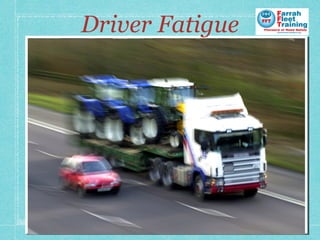
Driver Fatigue Presentation
- 2. Driver fatigue is thought to cause: at least 20% road accidents of occupational road users 1 in 5 accidents on motorways and trunk roads each death on road costs up to £1.2m- human costs incalculable
- 3. Driving too tired results in micro sleep
- 4. Micro sleep happens when: Eyelids fall briefly Head drops to one side
- 5. In 2001, a land rover ploughed onto a railway line and killed 6 people At least 40,000 serious injuries 2010/2011 Nearly 3,500 deaths 2010/2011
- 6. Most driver fatigue occurs: Between 2am and 6am Between 2pm and 4pm
- 7. Never ignore drowsiness Take a break and rest
- 8. What can I do? Turn off cruise control Turn down car temperature to a cool temperature Plan your journey and identify rest points At main roads or motorways take a break at designated areas
- 9. Have a caffeinated drink Have a short "power nap"
- 10. Don't become a statistic Maintain a regular sleep pattern Take adequate rest and sleep before driving Avoid alcohol or medication which can affect driving
